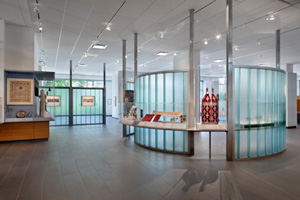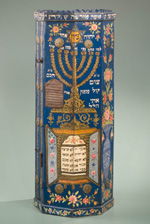Arts
Exhibit
The Arts: For the Ages-and Aged

A nursing home is not the most obvious place to house a new, contemporary Jewish museum, but that is one of a number of surprises awaiting visitors to the Derfner Judaica Museum in New York.
Among the first things one notices in the new Derfner Judaica Museum on the campus of the Hebrew Home for the Aged in Riverdale is how modern the space feels. The 5,000-square-foot exhibit area is surrounded by windows on three sides—one offering a view of one of New York’s few outdoor sculpture gardens with the impressive backdrop of the Hudson River and the New Jersey Palisades. The museum’s other two walls of windows look out onto the campus’s Winter Garden and Solarium. The partial walls inside the museum are translucent, increasing the feeling of openness and the flow of light.
However, the most remarkable aspect of this bright and contemporary museum is its location at the Hebrew Home, a state-of-the-art nursing facility in a residential section of the Bronx. The 19-acre campus has nearly 1,000 residents in facilities ranging from nursing care to assisted living; additionally, the Hebrew Home’s short-term rehabilitation programs, adult day and night care, respite program for caregivers and elder shelter serve more than 3,000 people annually.
The newly renovated museum opened to the public and residents last June. Architect Louise Braverman was highly conscious of the accessibility of art when designing the gallery. The exhibit space is entirely wheelchair accessible; a wide ramp leads from the entrance into the main display area. Artwork is arranged slightly lower down than in most museums, for people in wheelchairs to see easily: Conveniently, Chief Curator Susan Chevlowe points out, this also makes the display accessible for children. The museum often hosts visiting day school and Hebrew school groups when they come to the campus to visit residents.
Formerly housed on the fifth floor of the assisted living building, the expanded museum is now located on the main floor of the Jacob Reingold Pavilion. The new location is fitting, explains Malka Margolies, communications director at the Hebrew Home, because Reingold, as executive director of the Hebrew Home from 1958 to 1995, first initiated the now-famous art program there. “He was the one who envisioned bringing art into the nursing home—he used to borrow pieces from The Jewish Museum in New York to display [here],” she says. “He knew that most museum collections sit in storage and, unfortunately, most nursing home residents aren’t able to go to museums.”
Approximately 250 objects are on display in the museum’s inaugural exhibit “Tradition and Remembrance: Treasures of the Derfner Judaica Museum,” on view through 2010. When conceiving the exhibit, “it really struck me that Jewish ceremonial art is all about memory,” explains Chevlowe, who came to the Hebrew Home from The Jewish Museum in New York in March 2008. “Objects hold both individual and collective memory. The object becomes part of the transition between ritual meaning and personal meaning.”
This is especially poignant at the Hebrew Home, where the average age of residents is 87 and where 58 percent suffer from Alzheimer’s disease or another form of dementia. “You are everything you remember about yourself, and as people forget, this affects us—no matter what our age is,” Chevlowe adds.
The exhibit begins with objects from the Bezalel School of Art and Design, founded in 1906 in Jerusalem. The items reflect Bezalel’s goal of promoting a uniquely Jewish style of art—using biblical imagery and motifs combined with traditional Eastern materials and crafts and Western artistic influence. In addition to Jewish ritual objects, such as an engraved silver filigree Kiddush cup (ca. 1910), there are everyday objects with Jewish designs: a cigarette case adorned with an image of Rebekka pouring water for Abraham’s servant Eliezer; a deck of playing cards with symbols of Eretz Yisrael as suits and faces of biblical characters.

Courtesy of the
Derfner Judaica Museum
Down the wide ramp is the Torah scroll that forms the basis of the museum’s permanent collection, the legacy of Ralph and Leuba Baum. The scroll was badly damaged by fire in an Elmshorn, Germany, synagogue on Kristallnacht. The only one of the synagogue’s 13 Torahs that survived the war, it was given to Ralph Baum on a visit back to his native town in 1953. According to his wife, it was the need to share this Torah scroll with the greater community that inspired the couple to donate their extensive Judaica collection to the Hebrew Home.
The Baums’ sizable donation of ceremonial art led the Hebrew Home to found its museum, which originally opened to the public in 1982. The new, larger space was made possible by benefactors Helen and Harold Derfner and funded in part by a furnishings grant from the New York City Department of Cultural Affairs.
“Ralph Baum started to collect [items from prewar Europe] so that others would remember,” said Chevlowe. “For him, it was almost a salvage effort.” Next to the Torah are other items from the Baums’ collection, including silver filigree Torah finials from the mid-19th century with four tiers of bells and an early-18th-century pewter Seder plate engraved with the full text of Had Gadya.
The exhibit continues to the left, around the perimeter of the room, showcasing Jewish holiday objects. Many of these items attest to a common Jewish tradition and memory, despite huge geographical divides: an 18th-century silver Hanukka lamp from Frankfurt-am-Main stands near a Yemenite menora carved from stone.
Among the textiles on display is a particularly impressive matza bag, hand sewn at the Girls’ Orphan Home in Jerusalem in the late-19th century. The velvet bag is embroidered with an intricate design of metallic thread and couched fish scales—intended to give the look of mother of pearl at a fraction of the cost, according to Chevlowe.
Farther along is a section devoted to Jewish life-cycle objects, from knives used to perform a bris to special bridal garments. There is a yortzeit calendar from 1928 Vienna—indicating the dates of observance of a man’s yortzeit from 1930 through 1973—and an 1891 Persian ketuba decorated with birds and peacocks.
In the center of the room is a semicircular display area dedicated to Torah and daily prayer. A Torah case from Kashan, Persia, stands 4 feet tall. Made of painted wood and fabric, it is decorated with flowers and traditional Jewish motifs—the Ten Commandments, a menora, Stars of David and Hebrew verses. There is a display of Torah pointers from around the world, including England, Russia, Central Europe, Persia, Iraq, Germany, Holland and the United States. The most unique among the group are a coral pointer from Italy and one made of porcelain from France.
Several of the items on display in this section are from the Hebrew Home’s original location in Harlem. The Hebrew Home traces its roots to the Beth Medrash Hagadol, on East 105th Street in New York, founded in 1910. The synagogue was left unlocked at night, and people arriving for morning services often found poor, elderly Jews sleeping on benches inside. The synagogue began providing meals as well, and by 1917 it was a full-scale shelter, known as the Hebrew Home for the Aged in Harlem. The Hebrew Home moved to its current location in Riverdale in 1951. On display from the original synagogue are a carved wood Decalogue with painted gold leaf, two crowned lions, Torah finials and a Torah shield engraved with the Hebrew Home’s first name, Moshav Zekeinim de-Harlem, and the street address, both in Hebrew lettering.
The final area of the museum is devoted to rotating exhibits of contemporary art with Jewish themes. The current show is a selection of photographs by Frédéric Brenner from his series “Jews/America/A Representation.” It is a creative exploration of what it means to be Jewish in the United States, from a photo of the students from a Jewish day school in Las Vegas at the Luxor Hotel on the Strip to a row of women donning tefilin at the Jewish Theological Seminary in New York.
Hyman Martin, 86, a resident at the Hebrew Home for four years, is a regular visitor to the Derfner Museum. “To me personally these are not artifacts,” he said about the museum’s collection. “They are symbols. Like the rituals, they are reminders of something we should or should not do.” Martin recently donated to the museum Sabbath candlesticks, a Kiddush cup and a spice box that had belonged to his wife’s family.
Though Martin is American born and never lived in Europe where many of the objects come from, he still finds them particularly meaningful. “Especially around the holidays,” he added, “I really miss my parents—these are symbols that tie me to my family.”
While visiting the Hebrew Home, it’s worth a stop at three smaller displays near the museum. Just across the Winter Garden is a small room of miniatures dedicated to an exhibit by Ruby G. Strauss, titled “Pickles and Egg Cream.” The familiar strains of “Bei Mir Bist Du Shayn” greet you when you walk into the room, made up of charming miniature dioramas from Strauss’s childhood in New York of the 1930s. This display is fun for younger audiences as well as nostalgic for those who remember the era. Also exciting for children, down the hall past the café is a model train display designed by Paul Busse, famous for his holiday train show at the New York Botanical Garden in the Bronx. “In addition to the residents, art should engage visitors, who are often grandchildren,” says Margolies.
The campus’s Elma and Milton A. Gilbert Pavilion Gallery also displays rotating exhibits. The current show, through mid-January 2010, is “Shana: My Muse/Assemblage of Works” by Riverdale resident Alexandra Zizmor. The artist uses paint, ink, collage and found objects to depict her Great Dane, Shana, performing various activities.
From the museum to the sculpture garden to the corridors lined with lithographs and prints by artists such as Picasso and Warhol, it is clear that art is an integral part of the campus of the Hebrew Home, making it a welcoming environment for both residents and visitors, young and old. H
Visiting the Derfner Judaica Museum
5901 Palisade Avenue
Riverdale, New York
718-581-1596; www.hebrewhome.org
Monday through Friday, 10:30 A.M. to 4:30 P.M.; visitors may call ahead for scheduled Sunday hours; admission is free.
Rachel Schwartzberg is an editor at Hadassah Magazine. She is currently working on a book of her memoirs.










 Facebook
Facebook Instagram
Instagram Twitter
Twitter
Leave a Reply